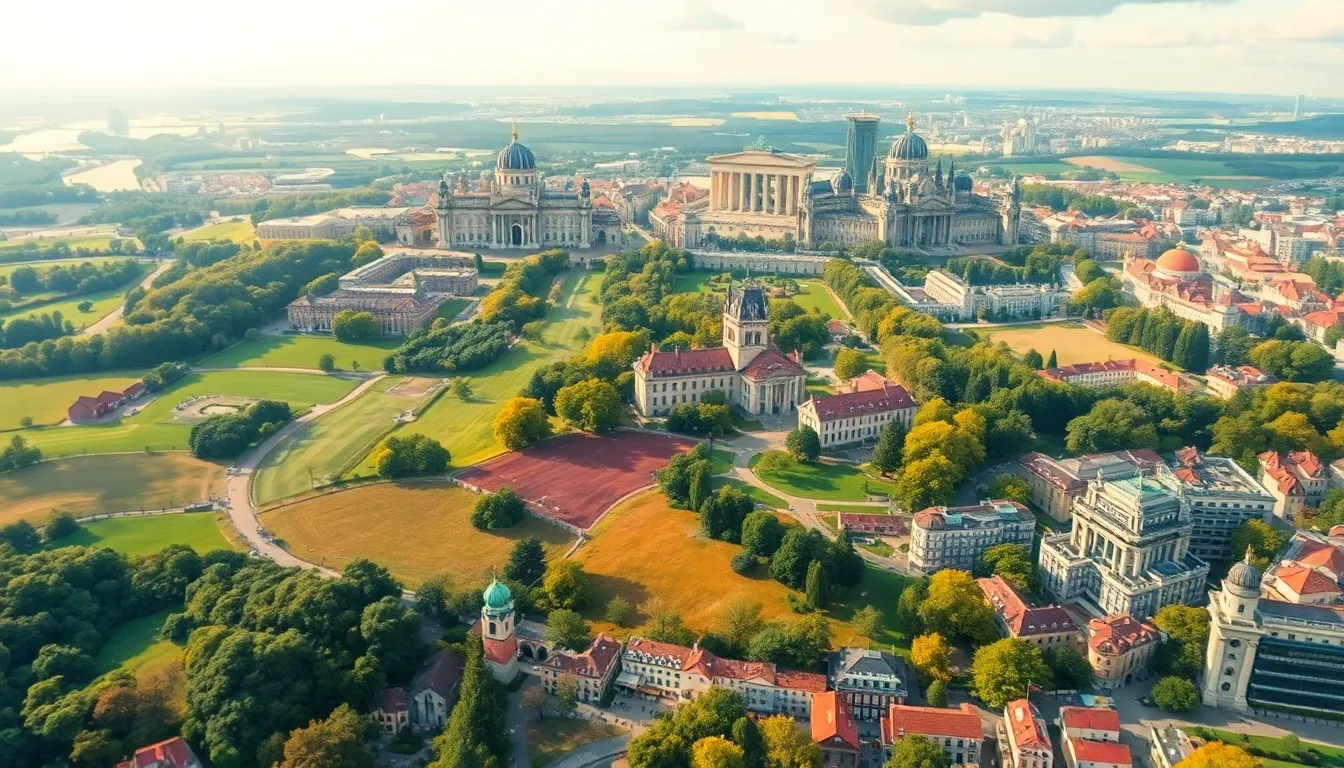Germany, the land of beer, bratwurst, and some seriously impressive engineering, is nestled right in the heart of Europe. But what region is it actually in? While most people might think of Germany as just being a single country, it’s much more than that. It’s a vibrant tapestry of culture, history, and geography that deserves a closer look.
Table of Contents
ToggleGeographic Location of Germany
Germany lies in central Europe, bordered by nine countries. To the north, it meets Denmark while to the east, it shares borders with Poland and the Czech Republic. Austria and Switzerland are located to the south, and France, Luxembourg, Belgium, and the Netherlands are positioned to the west.
The North Sea and the Baltic Sea define the northern edges of the country. Rivers such as the Rhine, Elbe, and Danube flow through Germany, enhancing its geographic significance. Mountains like the Alps and the Erzgebirge create natural borders with neighboring nations.
Important geographic features include extensive forests, fertile plains, and numerous lakes. Regions such as Bavaria, characterized by rolling hills and traditional alpine culture, contrast with the industrial landscapes of North Rhine-Westphalia. Coastal areas show a unique maritime climate, providing diverse ecosystems.
Located in the heart of Europe, Germany serves as a vital hub for commerce and transport. Its cities, like Berlin and Munich, act as major economic centers, connecting various European markets. Rail networks and highways link Germany to surrounding countries, fostering an environment for trade and tourism.
Climatic conditions vary across regions, influenced by geographical factors. The southern regions experience warmer, temperate weather, while the north has a cooler, oceanic climate. This variability fosters a rich array of flora and fauna across Germany’s landscapes.
Geographic diversity contributes to Germany’s extensive cultural heritage, making it a significant player in European affairs. The nation’s location not only facilitates travel but also enriches its history and connections to neighboring regions.
Political Regions of Germany

Germany consists of 16 federal states, known as Bundesländer. Each state possesses its own government, unique culture, and specific administrative functions.
Federal States Overview
Bavaria, the largest state, is famous for its traditions and Oktoberfest. Baden-Württemberg, home to Stuttgart, thrives with its automotive industry. North Rhine-Westphalia is densely populated, housing major cities like Cologne and Düsseldorf. Hamburg, a city-state, stands out with its significant port. Other states, such as Hesse, Saxony, and Thuringia contribute to the rich diversity in culture and economy. Schleswig-Holstein borders the North Sea and Baltic Sea, showcasing picturesque coastlines. Brandenburg encircles Berlin, offering various landscapes including forests and lakes. Saxony-Anhalt combines historical sites with industrial development.
Key Cities and Their Regions
Berlin serves as Germany’s capital and a political hub. Munich, located in Bavaria, attracts visitors with its vibrant cultural scene. Frankfurt stands out as a financial center, where international banking thrives. Stuttgart, known for its automotive history, is home to major manufacturers like Porsche and Mercedes-Benz. Düsseldorf boasts a strong presence in fashion and trade fairs. Leipzig, with its growing population, combines modernity with rich history. Dresden, known for its baroque architecture, lies in Saxony. Each of these cities plays a crucial role in shaping Germany’s regional identity.
Cultural Regions of Germany
Germany’s cultural regions showcase a rich tapestry of traditions and practices. Diverse customs reflect the country’s historical influences and regional identities.
Distinctive Traditions and Practices
Bavaria is renowned for Oktoberfest, celebrating beer culture with lively music and traditional attire. In contrast, the Rhineland features carnival celebrations, marking a vibrant season of parades and festivities. Each region upholds unique culinary specialties, with Saxony famous for its delicious pastries and North Rhine-Westphalia offering hearty dishes. Festivals such as the Christmas markets attract visitors nationwide, highlighting Germany’s festive spirit. Folk dances and regional music, like Bavarian polka and Swabian folk songs, emphasize the cultural heritage. Regional dialects further add depth, influencing local customs and daily interactions.
Influential Cultural Centers
Berlin stands out as a hub for arts and innovation, hosting world-class museums and galleries. Munich follows closely, offering a blend of history and modernity, with a strong focus on performing arts. Frankfurt serves as a financial center, yet it also boasts a thriving cultural scene, including theaters and exhibitions. Hamburg is known for its vibrant music scene, particularly in the realm of rock and classical genres. Dresden blends history and modern culture, featuring stunning architecture and art collections. Cities like Leipzig provide a nurturing environment for emerging artists, contributing to Germany’s evolving cultural landscape. Each center enriches the nation’s identity, fostering creativity and collaboration.
Economic Regions of Germany
Germany comprises several economic regions, each contributing uniquely to the nation’s overall economy. North Rhine-Westphalia ranks as the most populous state, hosting significant industries such as coal, steel, and electronics. Bavaria, known for its robust automotive sector, features major companies like BMW and Audi.
Baden-Württemberg follows closely, recognized globally for its engineering prowess, especially in automotive and machinery production. The state’s cities like Stuttgart and Mannheim prioritize innovation and economic development.
In the eastern part of Germany, states such as Saxony and Thuringia focus on technology and microelectronics, attracting investment and fostering high-tech industries. Saxony’s capital, Dresden, embodies this transformation with a growing tech scene.
The economic landscape also highlights Hamburg as a pivotal port city, serving as a gateway for international trade and logistics. Its strategic location bolsters Germany’s export capabilities, especially for goods flowing through the North Sea.
Hesse plays a vital role, hosting Frankfurt, Europe’s financial powerhouse, where numerous banks and financial institutions operate. This concentration of financial services solidifies Hesse’s status as a crucial player in global finance.
Economic indicators show regional disparities, with areas like Berlin transitioning from industrial to service-oriented economies, emphasizing technology, startups, and creative industries. The diverse economic regions reflect Germany’s adaptability and resilience, showcasing strengths across various sectors.
Overall, these economic regions collectively enhance Germany’s position within the European and global context.
Germany stands out as a vibrant and multifaceted region in central Europe. Its diverse landscapes cultural richness and economic strengths make it a key player on the European stage. From the picturesque hills of Bavaria to the bustling streets of Berlin each area contributes to the nation’s unique identity.
The blend of history tradition and modernity in its cities fosters a dynamic environment for both residents and visitors. As Germany continues to evolve it remains a testament to the importance of regional diversity in shaping a nation’s character and influence. Exploring this remarkable country offers a deeper understanding of its role in Europe and beyond.






